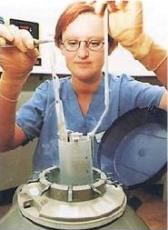
"انتقال جنین منجمد شده "
The timing of the embryo transfer depends on a number of factors including the cell stage of the embryo when frozen and uterine receptivity. It is essential that a Frozen cycle procedure form be completed and returned to the clinic well before the scheduled thaw date.
............. ادامه مطلب ...........
Frozen Embryo Transfer
This brief, painless procedure involves the doctor placing a catheter that has been loaded with a selected number of embryos by the Embryologist, through the cervix and into the uterus to deposit the embryos. When possible Blastocyst transfers are done, which occur around day five of embryonic growth. Blastocyst transfers allow a more mature embryo to be transferred, allowing the Embryologist to select fewer embryos for transfer, achieving a high pregnancy rate with a lower risk of multiple gestations above twins. Occasionally, cleavage stage, day three of embryonic growth transfer are done at they recommendation of the Embryologist based on the quality of the embryo.
When more eggs are retrieved than needed, we can freeze them for future use (cryopreservation). Embryos can be frozen at any stage between day one and day six after egg retrieval and can be stored for up to five years. We offer frozen embryo transfer at our Valencia, Beverly Hills, and Burbank offices to allow you the chance of conception when the time is right for you.
The frozen embryo transfer process is less invasive than standard egg collection. Frozen embryo transfer can be done during your natural cycle, or we may need to control your cycle with medication depending on whether we can monitor the time of your natural ovulation. The embryos are placed into your uterus at the time of ovulation and the when the thickness of the endometrium (lining of your uterus) is right.
Before the frozen embryo transfer can be performed, your embryos will need to be thawed so the age of the embryos corresponds to the age of your uterine lining. The timing of frozen embryo transfer usually depends on the stage at which the embryos were frozen.
Not all embryos survive the cryopreservation process. Before the frozen embryo transfer, we will evaluate your embryos to make sure they are ready for transfer. If they are, then the frozen embryo transfer can go forward.
The embryo transfer is usually performed two days after ovulation. During the procedure a catheter is inserted through the cervix and the embryos are placed injected into the uterus. The frozen embryo transfer usually takes about 15 minutes.
The success rate of frozen embryo transfer is almost as successful as standard IVF. Success depends on several factors, including the number and quality of embryos, your age, and the cause of infertility.